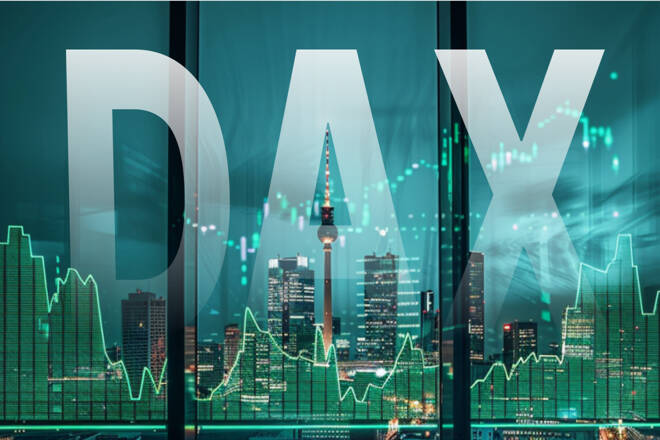Advertisement
Advertisement
DAX Index Today: Will German Producer Prices and FOMC Insights Shift DAX Market?
By:
Key Points:
- The DAX fell by 0.45% on Thursday, July 18, ending the session at 18,355.
- German producer prices will draw investor interest on Friday, July 19.
- FOMC Member speeches need monitoring as investors speculate about the chances of multiple 2024 Fed rate cuts.
DAX Extends Losing Streak to Four Sessions
On Thursday, July 18, the DAX fell by 0.45%. Following a 0.44% loss on Wednesday, July 17, the DAX ended the session at 18,355. Significantly, the DAX declined for the fourth session, its longest losing streak since December 2023.
Thursday DAX Market Movers
The tech sector sell-off gained momentum.
Siemens AG and Siemens Energy AG led the way down, sliding by 4.42% and 2.32%, respectively.
Infineon Technologies declined by 1.35%, while SAP ended the session down 1.46%,
ECB Rate Cut Uncertainty
The ECB held interest rates steady on Thursday. ECB President Christine Lagarde stated that the ECB remained data-dependent.
Pictet Group Head of Macroeconomic Research Frederik Ducrozet commented,
“The ECB is in no rush to ease again and won’t pre-commit to a particular rate path, but recent data points haven’t materially changed the outlook. The ECB remains on track to cut rates at a quarterly pace.”
German Economic Data: Producer Prices in Focus
On Friday, July 19, German producer prices will draw investor interest.
Economists forecast producer prices to fall 1.6% year-on-year in June after a decline of 2.2% in May. Better-than-expected numbers may suggest improving demand. Producers raise prices as demand increases, passing costs onto consumers.
Investors expect a September ECB rate cut. Signals of improving demand and sticky consumer price inflation could shift sentiment and impact demand for DAX-listed stocks.
A higher-for-longer rate path would leave firms exposed to elevated borrowing costs. Higher borrowing costs affect profits and stocks negatively.
US Market Impact
Later in the session on Thursday, US labor market data failed to boost demand for DAX-listed stocks.
Continuing jobless claims increased from 1,847k in the week ending June 29 to 1,867k in the week ending July 6. Higher claims signaled a deterioration in labor market conditions. Wage growth could slow, reducing disposable income and demand-driven inflationary pressures.
A softer inflation outlook may fuel speculation about the possibility of multiple 2024 Fed rate cuts. A more dovish Fed rate path would boost the appetite for riskier assets.
Wall Street Journal Chief Economics Correspondent Nick Timiraos shared views from JPMorgan (JPM) on the numbers:
“Big labor supply gains mean it is enjoying a downtrend in wage inflation – not evident elsewhere. As a result, the US is poised to have the largest slide in 2H24 inflation among major economies.”
US Market Trends
On Thursday, the US equity markets succumbed to profit-taking. The Nasdaq Composite Index and the S&P 500 saw losses of 0.70% and 0.78%, respectively, while the Dow slid by 1.29%.
On Thursday, FOMC Members could influence the Fed rate path and the DAX.
US Economic Calendar: FOMC Members in Focus
On Friday, FOMC voting Members Raphael Bostic and John William will speak.
Views on inflation, the economic outlook, and the timing of Fed rate cuts are pivotal.
Support for a soft landing, a sharp decline in inflation, and September and December Fed rate cuts could give the DAX a look at 19,000.
Near-Term Outlook
Near-term DAX trends depend on German producer prices and FOMC Member speeches. Lower-than-expected producer prices could ease inflation concerns and raise bets on a September ECB rate cut. A more dovish ECB rate path would push the DAX toward 19,000. Fed support for multiple 2024 Fed rate cuts may also boost demand for DAX-listed stocks.
In the Futures markets, the DAX was down 31 points while the Nasdaq mini was up by 56 points.
Investors should remain alert with inflation and the Fed in focus. Monitor the news wires, economic data, and expert commentary to manage trading strategies. Stay up-to-date with our latest news and analysis to manage risk.
DAX Technical Indicators
Daily Chart
The DAX hovered above the 50-day and 200-day EMAs, sending bullish price signals.
A DAX return to the 18,500 handle could signal a move toward 18,750. A break above 18,750 could give the bulls a run at the May high of 18,893.
German producer prices and FOMC Member commentary require consideration.
Conversely, a DAX break below the 50-day EMA could give the bears a run at 18,000.
The 14-day RSI at 48.38 suggests a DAX drop to 18,000 before entering oversold territory.
4-Hourly Chart
The DAX sat below the 50-day EMA while holding above the 200-day EMA. The EMAs sent bearish near-term but bullish longer-term price signals.
A break above the 50-day EMA would support a return to 18,500.
However, a DAX drop below the 200-day EMA would bring 18,000 into play.
The 14-period 4-hour RSI at 41.98 indicates a DAX return to 18,000 before entering oversold territory.
About the Author
Bob Masonauthor
With over 28 years of experience in the financial industry, Bob has worked with various global rating agencies and multinational banks. Currently he is covering currencies, commodities, alternative asset classes and global equities, focusing mostly on European and Asian markets.
Advertisement
